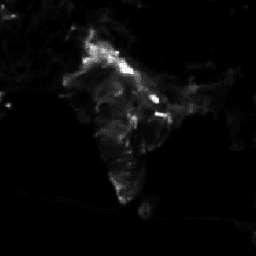
- Disponibilidade de conjuntos de dados
- 2018-01-01T00:00:00Z–2025-10-18T12:00:00Z
- Provedor de conjunto de dados
- NASA / GMAO
- Tags
Descrição
Esse conjunto de dados contém a repetição meteorológica (rpl) de dados de alta frequência temporal (htf). O sistema Goddard Earth Observing System Composition Forecast (GEOS-CF) é um sistema global de previsão de constituintes de alta resolução (0,25°) do Global Modeling and Assimilation Office(GMAO) da NASA.
O GEOS-CF oferece uma nova ferramenta para pesquisa de química atmosférica, com o objetivo de complementar a ampla gama de observações espaciais e in situ da NASA. O GEOS-CF expande o sistema de modelagem de clima e aerossóis GEOS ao introduzir o módulo de química GEOS-Chem para fornecer previsões retrospectivas e de cinco dias de constituintes atmosféricos, incluindo ozônio (O₃), monóxido de carbono (CO), dióxido de nitrogênio (NO₂), dióxido de enxofre (SO₂) e material particulado fino (PM2,5). O módulo de química integrado ao GEOS-CF é idêntico ao modelo off-line GEOS-Chem e se beneficia das inovações fornecidas pela comunidade GEOS-Chem.
A avaliação do GEOS-CF em relação a observações de satélite, ozonosonda e superfície nos anos de 2018 a 2019 mostra concentrações simuladas realistas de O3, NO2 e CO, com vieses médios normalizados de -0,1 a 0,3, erros quadráticos médios normalizados entre 0,1 e 0,4 e correlações entre 0,3 e 0,8. As comparações com observações de superfície destacam a representação bem-sucedida de poluentes do ar em muitas regiões do mundo e durante todas as estações do ano, mas também mostram limitações atuais, como um alto viés global no SO2 e uma previsão excessiva de O3 no verão no sudeste dos Estados Unidos.
A GEOS-CF v1.0 geralmente superestima os aerossóis em 20% a 50% devido a problemas conhecidos na GEOS-Chem v12.0.1, que foram resolvidos em versões posteriores. As previsões de cinco dias têm pontuações de habilidade comparáveis à previsão retrospectiva de um dia. As habilidades do modelo podem ser significativamente melhoradas aplicando uma correção de viés à saída do modelo de superfície usando uma abordagem de machine learning.
Bandas
Tamanho do pixel
27750 metros
Bandas
| Nome | Unidades | Tamanho do pixel | Descrição |
|---|---|---|---|
CO |
Fração molar | metros | Razão de mistura de volume de monóxido de carbono (CO, MW = 28,00 g mol-1) ar seco |
NO2 |
Fração molar | metros | Proporção de mistura de volume de dióxido de nitrogênio (NO2, MW = 46,00 g mol-1) ar seco |
O3 |
Fração molar | metros | Proporção de mistura de volume de ozônio (O3, MW = 48,00 g mol-1) ar seco |
PM25_RH35_GCC |
ug m-3 | metros | Material particulado com diâmetro abaixo de 2,5 μm RH 35 |
PM25_RH35_GOCART |
kg/m^3 | metros | Total de PM2.5 reconstruído RH 35 |
Q |
Fração mássica | metros | Umidade específica |
RH |
metros | Umidade relativa após umidade |
|
SLP |
Pa | metros | Pressão ao nível do mar |
SO2 |
Fração molar | metros | Proporção de mistura de volume de dióxido de enxofre (SO2, MW = 64,00 g mol-1) ar seco |
T |
K | metros | Temperatura do ar |
U |
m/s | metros | Vento de leste |
V |
m/s | metros | Vento do norte |
Termos de Uso
Termos de Uso
Salvo indicação contrária, todos os dados produzidos pela NASA podem ser usados para qualquer finalidade sem permissão prévia. Para mais informações e exceções, acesse a página da Política de Dados e Informações da NASA (em inglês).
Citações
Keller, C. A., Knowland, K. E., Duncan, B. N., Liu, J., Anderson, D. C., Das, S., ... & Pawson, S. (2021). Descrição do sistema de modelagem de previsão de composição GEOS da NASA, GEOS-CF v1. 0. Journal of Advances in Modeling Earth Systems, 13(4), e2020MS002413. doi:10.1029/2020MS002413
DOIs
Explorar com o Earth Engine
Editor de código (JavaScript)
var imageVisParamNO2 = { 'bands': ['NO2'], 'min': 6.96e-11, 'max': 4.42e-8, }; var imageVisParamT = { 'bands': ['T'], 'min': 220, 'max': 320, 'palette': ['d7191c', 'fdae61', 'ffffbf', 'abd9e9', '2c7bb6'], }; var geosCf = ee.ImageCollection('NASA/GEOS-CF/v1/rpl/htf'); Map.setCenter(100, 20, 3); var weeklyT = geosCf.select('T').filterDate('2019-06-01', '2019-06-08').median(); Map.addLayer(weeklyT, imageVisParamT, 'Weekly T', false, 1); var NO2 = ee.Image('NASA/GEOS-CF/v1/rpl/htf/20190601_0000z'); Map.addLayer(NO2, imageVisParamNO2, 'NO2', true, 1);
